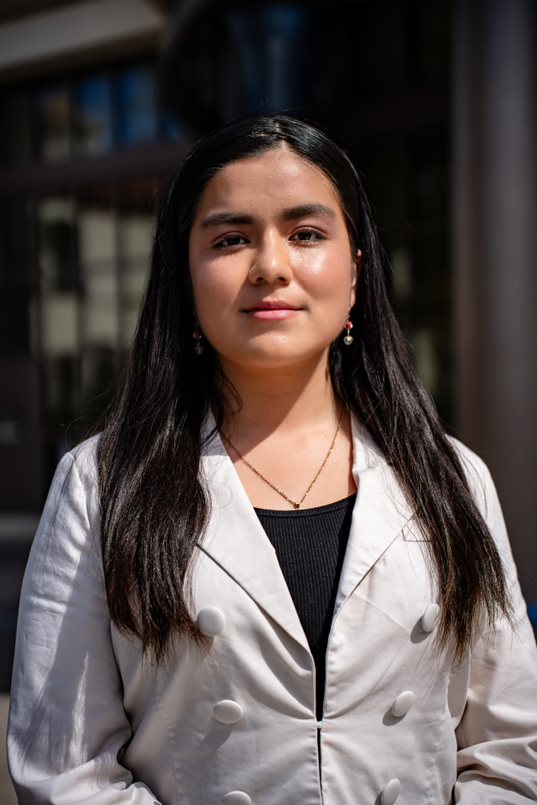The Impact of Youth Research at Western High School

Introduction
There is no greater achievement than getting closer to a solution that taps into the power of communities to truly change and improve the future for those communities. Throughout the school year at Western High School, our student body was provided opportunities to take lessons from the classroom and apply them in the real world. As students participating in the North Orange County Regional Occupational Program (ROP) Public Health & Social Work Pathway at Anaheim Union High School District, we were given an inside look at communal health advocacy through the lens of our neighborhoods. We developed research initiatives to gain a richer understanding of the science of protecting and improving the health of our communities. Throughout the process, the community schools initiative in my school and our medical pathways converged to enhance and enrich scholars’ soft and hard skills. For me, the research component allowed me to dive deeply into housing and food insecurity in my community. I was also afforded the opportunity to address these issues in innovative ways that can authentically support students and families facing these issues. The culmination of my research project and internship contributed to the creation of “La Bodeguita,” a food pantry at my school. The power of student research led the way to viable solutions. I was awarded the prestigious Rising Scientist Award by the Child Mind Institute for my study of homelessness and food insecurity in my community and how these factors impact mental health and overall well-being. Through this project, I realized how much I can actively do to enhance public health for my peers and their families.
The power of student research led the way to viable solutions.”
Expanding My Learning: The Regional Occupational Program
My learning experiences have been greatly enriched through project-based learning that includes elements like in-depth research, hands-on lab work, ethical practices, and a broadened outlook on communities beyond my own. Through the Regional Occupational Program (ROP) courses, I’ve had the privilege to witness professionals in action and thoroughly interview them about their education and profession. Additionally, I’ve learned how to apply my academic knowledge to real-world issues, particularly within the healthcare system. Participating in Western High School’s North Orange County Regional Occupational Program (NOCROP) community health courses and being an active member of the Health Occupations Students of America (HOSA) organization on campus has opened my eyes to the world of dynamic research in the community. I’ve been able to apply this research to potential future approaches that could benefit my area. For instance, delving into the health challenges facing my low-income community and collaborating with peers to develop solutions has honed my research skills. This process demanded hours of critical thinking, hands-on laboratory work, and public engagement. The experience equipped me with strength and knowledge, both personally and professionally, to make a meaningful impact on my community. Overall, my high school journey has been one of continuous growth, driven by a passion for making a positive difference in the healthcare system and the well-being of communities. An impactful moment was my active involvement in the Allied Health Research Group at Cal State Fullerton, where I honed my skills in research and healthcare within the Anaheim Unified School District. My focus was on improving our understanding of the challenges faced by unhoused individuals and the equity issues in healthcare access. The Allied Health Research Group supported my learning through mentorship and real-life application of research principles.
Developing My Research Project: Understanding the Impact of Homelessness in my Community.
I was very interested in understanding homelessness in my community. In collaboration with the Anaheim Union High School District, I delved into data from research surveys, comparing our findings with data from Anaheim City and surrounding areas. Through this analysis, I highlighted the disparities in resources for unhoused and underrepresented families in the vicinity of Western High School. One of the most significant aspects of my research was discovering the extent to which students were either directly impacted by unstable housing or were at risk of being affected. Armed with these insights, I presented my findings to a group of teachers on campus, advocating for changes in how Western High School supports these vulnerable students and their families. My presentation, “Exploring Anaheim’s McKinney-Vento Families: Lifelong Impact on Health Outcomes,” guided the audience through a process to better understand the conditions for unhoused students and families. I framed the conversation leveraging the language in the McKinney-Vento Act which expands the definition of homelessness to encompass limited or no housing. Through this Act students and their families have explicit rights to an uninterrupted education and additional supports.
My research aimed to shed a light on the heightened risk of mental illness, substance use disorders, and physical health issues among Anaheim’s population that are considered homeless under the McKinney-Vento Act. Starting with a survey, my research sought insights into the perspectives and solutions regarding homelessness among students in the Anaheim Union High School District. Out of 65 respondents, a significant majority agreed they had witnessed homelessness disparity in Anaheim. Additionally, 5 students expressed agreement with being at risk of homelessness, highlighting the urgency of the issue. Anaheim’s poverty rate of 16%, exceeds the national average of 12.4%. At Western High School, 6% of students are identified as youth experiencing homelessness under McKinney-Vento, which amounts to 111 students last year, with a projected 40 additional students for the current school year.
Using the Social Progress Index (SPI) and Center for Disease Control (CDC) Health Indicators, disparities in housing, nutrition, and basic care become evident, with Anaheim scoring low in these categories. Estimates from the National Alliance on Mental Illness highlight the prevalence of serious mental illness among Anaheim’s homeless population, compounded by chronic depression, anxiety, and stress. Anaheim faces significant health risks, including diabetes, cancer, obesity, high blood pressure, coronary heart disease, asthma, smoking, Chronic Obstructive Pulmonary Disease, and chronic kidney disease, as per CDC data. These factors contribute to a growing mental and physical health crisis within our district–leading to the very critical forewarning that without intervention, our students face severe setbacks in their physical and mental well-being. Through my research, I gained a deeper understanding of the pressing need to bolster in-person resources to tackle issues such as rent burden stemming from high rental costs juxtaposed with modest household incomes, as well as challenges related to food insecurity, access to clothing, and psychological well-being. It became evident that implementing sustainable solutions for families in our community is paramount to alleviate the enduring repercussions of homelessness on health outcomes. Effectively addressing the intricate challenges encountered by homeless families in Anaheim necessitates comprehensive interventions that prioritize holistic well-being. By championing for increased resources and advocating for sustainable solutions, we can endeavor to cultivate a healthier and more equitable community that caters to the needs of all its residents.
By championing for increased resources and advocating for sustainable solutions, we can endeavor to cultivate a healthier and more equitable community that caters to the needs of all its residents.”
Leveraging My Research Findings Through A Community-Based Internship
As a community school, my high school offers many spaces for students to realize their dreams through rich learning experiences that help us apply our learning in real-life contexts. After completing my research project, I had the opportunity to engage with district board members, allowing me to contribute to broader community discussions on issues affecting our student body. My community-based internship was located at my own school and through the community schools initiative I was able to leverage my research findings to address food insecurity by collaborating with other students and community members.
Based on the AUHSD needs and assets survey completed at the beginning of last school year (2022-2023), 33.37% or about 270 students from the 809 students surveyed reported basic needs as inaccessible. Students reported food insecurity as a critical issue they face. Guardians also reported basic needs including food, shelter, and clothing to be a barrier for themselves and their families, with a sum total of 31% or 313 guardians reporting this as a challenge. This survey launched our Beyond Western Tour, which resulted in the creation of our community pantry called “La Bodeguita.” Furthermore, my peers and I initiated our summer food drive to alleviate the decline in food accessibility that occurs when schools cease operation for the summer at our partner location. I also helped coordinate the Western Clothing Drive for all families in our area. To disseminate information about the resources accessible to the community, I contributed to the development of a media campaign comprising videos and social media posts.
Through my internship, I applied what I had learned as a researcher–I analyzed data and identified local community needs. I also applied the research to collaborate on a project that addressed food insecurity. Throughout this journey, I relied on my critical thinking, communication, and collaboration skills to navigate the complexities of community needs and to develop effective solutions. This opportunity made real the connection between soft and technical skills. I also gained insight into the power of being an engaged community member whose passion can lead to real change.
6 MINUTE READ
Read about the experiences of a student researcher from Western High School. The author shares what it felt like to develop her own research project to address a real issue facing her community and to see the project to fruition. She details how the project enriched her learning and continues to make lasting change in her school and community.
To support learning from this feature and the full issue, we’ve provided a discussion guide that spans the four features of the issue and includes discussion prompts related to the issues’s main themes.
TABLE OF CONTENTS
RESOURCES
For further learning, check out these websites, reports, lesson plans, magazine articles, and more. These resources are curated to speak to different audiences, including teachers, researchers, policymakers, and the general public.
CITATION
Rojas, D. (2024). The Impact of Youth Research at Western High School. Community Schooling, Issue 5, Spring 2024. Los Angeles, CA: UCLA Center for Community Schooling.
ABOUT THE RESEARCHER

Denise Rojas is a senior at Western High School and is enrolled in the Public Health & Social Work Pathway of AUHSD’s North Orange County Regional Occupational Program (ROP).
ACKNOWLEDGEMENTS
I want to thank wonderful individuals who made my journey in research memorable and possible. I’d like to thank my three mentors, Ms. Irlanda, Ms. Chavez, and Ms. Galarza. All were empowering women from whom I sought guidance for my personal life, my passions, and of course for this project. I’d also love to thank my mom, dad, and older brother, Diego, for their unconditional support and love for my community driven endeavors. Without them as my keystone foundation, I would not be where I am today.
EXTERNAL REVIEW
We are thankful to Jaune W. Reyes, UC Davis and Edwin Cruz, UCLA. Both students are graduates of the UCLA Community School in Los Angeles.



